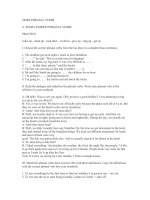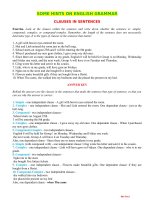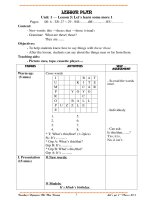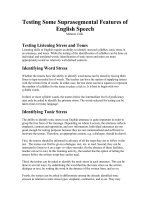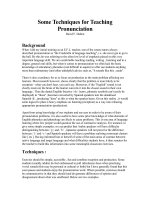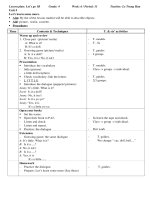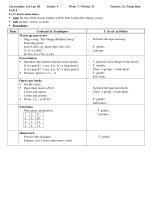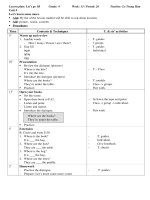Some Empirical Observations
Bạn đang xem bản rút gọn của tài liệu. Xem và tải ngay bản đầy đủ của tài liệu tại đây (21.39 KB, 7 trang )
The Volatility of Capital Flows in South Africa:
Some Empirical Observations
By
Michael Nowak
African Department
International Monetary Fund
Prepared for BER Conference, Johannesburg, June 1, 2001
The views expressed in this paper are those of the author and do not necessarily represent
those of the International Monetary Fund. Research assistance was provided by Ms. Pamela
Mjandana and Mr. Nehrunaman Pillay.
- 2 -
The Volatility of Capital Flows in South Africa: Some Empirical Observations
I. SUMMARY AND CONCLUSIONS
In the past several years, South Africa has taken a number of steps, such as budget-deficit
reduction and adoption of a more flexible exchange rate regime, that have helped reduce its
vulnerability to adverse external shocks. In addition, the SARB has made considerable strides
in reducing the net open forward position (NOFP), which has represented a major source of
external vulnerability, has been lowered significantly. The NOFP, however, remains
relatively large. As such, it continues to represent a source of concern to investors that is
reflected in South Africa’s sovereign risk spreads. The SARB has, therefore, expressed its
commitment to achieving further reductions.
This note examines alternative options available to the SARB for reducing the NOFP. On the
basis of some preliminary statistical findings, it argues that:
?? Regular pre-announced foreign exchange purchases may help bring about up-front
cuts in borrowing spreads, but could place undue pressure on the rand, the external
current account, and the real economy.
?? Care should be taken in targeting capital inflows, such as FDI, that may be perceived
as stable; while such flows may indeed be less volatile than other capital flows, they
still tend to show little persistence over time. However, in the case of certain large
one-off inflows of FDI, such as privatization proceeds, there may be a strong basis to
suppose that the inflows will not be reversed. It makes sense, therefore, to purchase
some or most of these inflows.
?? The evidence tentatively suggests that incoming FDI may be partially offset by long-
term capital outflows, possibly reflecting cover operations by investors. However,
when the picture is extended to include all other capital flows, there is no significant
offset.
?? Additional external borrowing may be appropriate in modest amounts.
II. EXTERNAL VULNERABILITY AND BORROWING SPREADS
Over the course of the past several years, macroeconomic policies in South Africa have
helped reduce the vulnerability of the economy to adverse external shocks and contagion
from other emerging markets. The public finances have been brought firmly under control,
an inflation-targeting regime is now in place, and the exchange rate has been allowed to float
with a significant gain in external competitiveness. The banking system is strong and healthy.
In addition, South Africa’s medium- and long-term external debt remains low in comparison
with other emerging market economies (Table 1). And the SARB’s net open forward position
- 3 -
(NOFP), which is a measure of its short-term foreign currency exposure, has been reduced by
nearly two-thirds since the currency crisis of 1998.
Nevertheless, the NOFP and other indicators of international reserve adequacy remain a
source of concern for investors that is reflected in South Africa’s sovereign risk spreads
(Figure 1). The relationship between the NOFP and borrowing spreads has been quantified
by Jonsson (2001),
1
who found that a reduction of US$1 billion in the NOFP was typically
associated with a decline in spreads of nearly 15 basis points.
2
This means that the cut in the
NOFP from its recent peak of US$23 billion (18 percent of GDP) in September 1998 to
US$9 billion (7 percent of GDP) at end-April 2001 would have helped lower spreads by over
200 basis points. Moreover, if the NOFP were to be reduced to zero, spreads could fall a
further 135 basis points. Narrower spreads should translate into lower long-term interest
rates.
III. REDUCING THE NOFP: THE OPTIONS
The benefits of lowering the SARB’s short-term foreign currency exposure are not seriously
contested. What is perhaps more debatable is the best means by which the SARB should
acquire the foreign exchange needed to reduce the NOFP. At least three options are
available:
?? To make regular purchases of dollars in the foreign exchange market according to a
predetermined schedule.
?? To acquire dollars in the foreign exchange market from capital inflows that are
considered relatively stable and persistent (so-called “cool” money).
?? To use the proceeds from additional medium-or long-term external borrowing.
Option 1: Regular purchases
The SARB could buy dollars in the spot market on a regular periodic basis in predetermined
amounts until the NOFP had been reduced to an acceptable level. This would have the
benefit of establishing a clear timetable for NOFP cuts and help allay concerns that the
process of NOFP reduction might be open-ended. Moreover, if the profile of purchases were
1
Jonsson (2001), “The Risk Premium in South African Long-Term Interest Rates,” IMF,
mimeo.”
2
This study identified other important determinants of South Africa’s risk spreads. These
included external borrowing (spreads are raised), reductions in the budget deficit (spreads are
lowered), contagion from other emerging markets, as captured by the Emerging Bond Market
Index (spreads are raised, but impact is small).
- 4 -
to be announced ahead of time, and if the exercise carried with it sufficient credibility, the
favorable impact on spreads and interest rates would likely take place up-front.
Despite its appeal, there are downside risks with such an approach. By stepping into the
market to purchase foreign exchange, irrespective of prevailing market conditions, the SARB
would be adding to pressure on the rand at times of weak investor sentiment. On such
occasions, the SARB may need to attract capital into the country by offering improved rates
of return. This could be done either by forcing a step exchange rate depreciation (and thereby
generating the expectation of a strengthening of the rand) or by raising interest rates. Under
either of these options, it would probably be both difficult and undesirable for the SARB to
maintain the higher rates of return for any sustained period of time. To do so could introduce
excessive exchange rate and/or interest rate volatility and, in the process, undermine the
SARB’s inflation-targeting strategy or hurt growth performance. Eventually, the return on
capital would need to decline, and the capital inflows would be reversed. The external current
account would, therefore, need to provide the necessary foreign exchange flows through a
large real currency depreciation, and this could place considerable strain on the real
economy.
In short, to expect the current account to improve by the equivalent of up to 7 percent of
GDP, even over a few years, is neither realistic nor advisable. Moreover, macroeconomic
policy would be “held hostage” to the objective of reducing the NOFP. Not surprisingly, the
SARB has chosen not to pursue this option.
Option 2: Identifying “cool” capital inflows
Rather than stepping into the market on a regular basis, one option might be for the SARB to
wait until South Africa enjoyed capital inflows and to make an assessment as to whether
these inflows were likely to stay. This approach would enable the NOFP to be lowered
without subjecting the rand to undue downward pressure or having to raise interest rates
keeping macroeconomic policy predictable.
The question that arises is what information would be useful to the SARB to help it make a
decision about when, how much, and what type of capital inflow to buy. Specifically, how
can the central bank make use of prior knowledge relating to the volatility and persistence of
capital flows? And how would the interaction between different types of capital flows affect
the decision to buy foreign exchange?
In principle, foreign direct investment (FDI) is commonly perceived as less volatile and less
likely to be reversed than so-called “hot money,” such as short-term capital. It has been
argued that, by their nature, FDI flows are driven by long-term sentiment and are more likely
to be “stable” than short-term flows. Moreover, to the extent that FDI entails physical
investment in plant and equipment, it is “illiquid” and, therefore, relatively difficult to
reverse.
- 5 -
However, the international evidence on whether FDI flows tend to be “cool” is mixed. On the
one hand, in a study of industrial and developing economies (which did not include South
Africa), Claessens, et al. (1995) concluded, that for most of the countries reviewed, FDI was
as volatile as other types of flows and that it was generally neither persistent nor predictable.
3
On the other, an IMF study argued that, during the recent Asia and Mexico currency crises,
FDI was relatively more stable, and less likely to be reversed, than other types of flows.
4
Let
us focus on these points.
Volatility
The table below presents standard deviations (as a measure of volatility) for different
components of South Africa’s capital account for the period since 1994 when capital controls
on nonresidents were liberalized.
5
The standard deviations are lowest for FDI and long-term
capital (which consists primarily of bank loans), suggesting that these flows are indeed less
volatile than other capital transactions. Surprisingly, perhaps, equity flows are markedly
more volatile than FDI even though the distinction between the two is somewhat arbitrary.
6
South Africa: Means and Standard Deviations for Capital Flows, 1994 Q1–2000 Q3
Mean Standard Deviation
FDI
Equity
Debt
Long-term
Short-term
-70.49
467.51
443.83
-111.40
107.27
499.23
789.42
1,037.78
356.06
897.90
Persistence
When considering buying inflows of capital, the central bank may wish to know the
likelihood of that type of inflow being repeated over a given period of time. To test for
persistence, we examined the autocorrelation properties of the major components of South
Africa’s capital account (Figure 3). The tests indicate that none of the components, including
3
Claessens, Dooley, and Warner (1995), “Portfolio Capital Flows: Hot or Cold?” World
Bank Economic Review, Vol. 9 (January).
4
IMF, 1998, “International Capital Markets: Developments, Prospects, and Key Policy
Issues,” Washington, D.C.
5
The data are quarterly and available from the IMF’s Balance of Payments Yearbook.
6
FDI covers an investment that involves an “effective voice in management,” usually
considered to be 10 percent or more of voting power in local enterprises.
